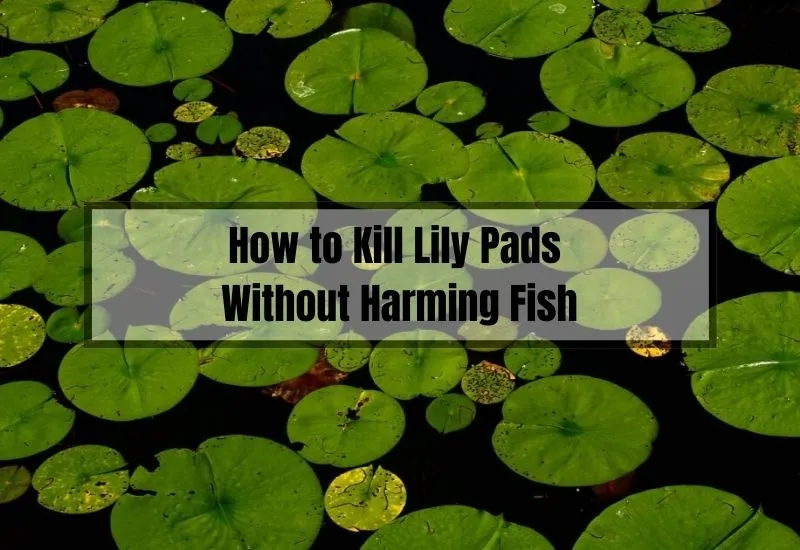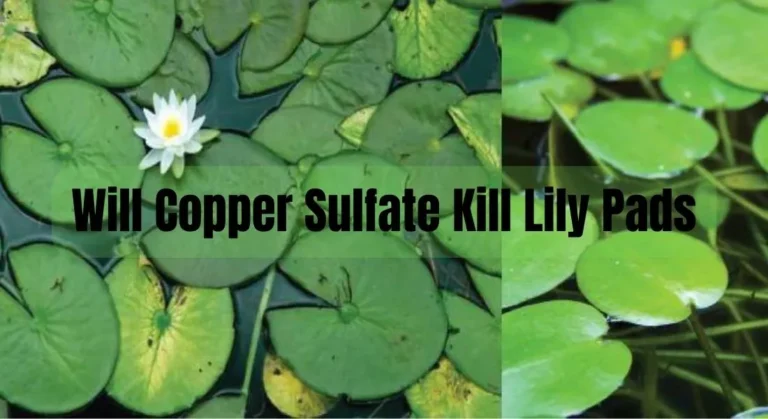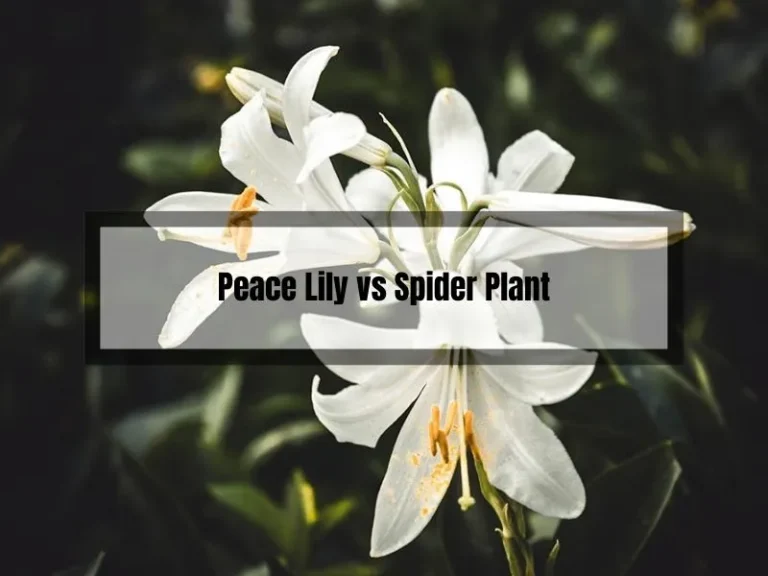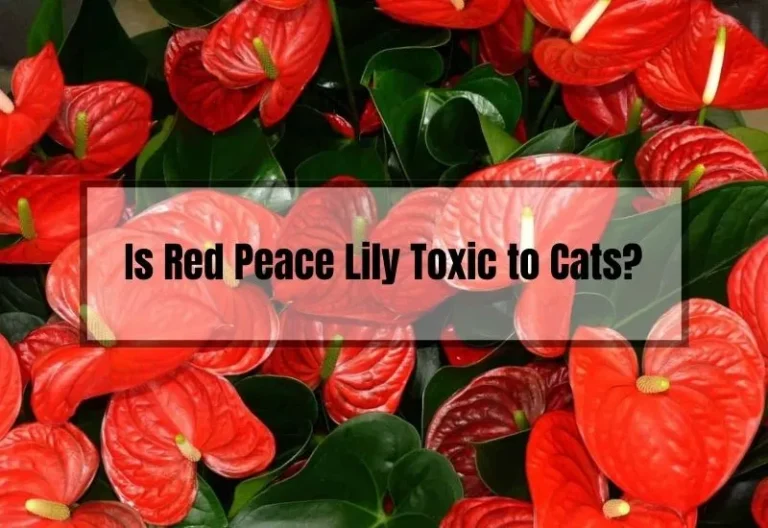How to Safely Eliminate Lily Pads Without Harming Your Fish
Concerned about lily pads taking over your pond without harming your fish? Lily pads can enhance your pond’s aesthetics but pose risks to aquatic life by blocking sunlight and consuming space.
This guide explores effective methods for lily pad removal without harming your fish: physical removal, chemical control (use cautiously), biological control, and preventive measures like reducing nutrient levels.
Key Takeaways
- Lily pads can harm your fish and other aquatic life by blocking sunlight and taking up valuable space.
- There are several methods to remove lily pads, including physical removal, chemical control (as a last resort), biological control, and preventive measures.
- Choose the method that works best for your pond and be careful not to harm your fish or other aquatic life.

Understanding Lily Pads and Their Impact on Pond Ecosystem
Lily pads are aquatic plants that grow on the surface of standing water, including ponds, lakes, and slow-moving streams. They are known for their large, round leaves that can grow up to 18 inches in diameter and their beautiful flowers that bloom in a variety of colors.
While lily pads can add aesthetic value to a pond, they can also cause harm to the pond ecosystem if left unchecked. Here are some of the ways lily pads can impact a pond:
- Oxygen depletion: Lily pads can cover a large portion of the pond surface, blocking sunlight from reaching the water below. This can cause a decrease in the amount of oxygen produced by aquatic plants, leading to oxygen depletion in the pond.
- Fish habitat: Lily pads can provide a habitat for fish, but if left unchecked, they can also take over the pond, making it difficult for fish to move around and find food.
- Algae growth: Lily pads can create a nutrient-rich environment that encourages the growth of algae, which can lead to an overgrowth of algae and other aquatic plants in the pond.
- Water quality: Lily pads can impact the water quality of the pond, making it difficult for other aquatic plants and animals to survive.
To maintain a healthy pond ecosystem, it is important to control the growth of lily pads. There are several methods for doing so, including mechanical removal, chemical treatment, and biological control. It is important to choose a method that is safe for the fish and other aquatic animals in the pond.
In the next section, we will discuss some methods for killing lily pads without harming fish.
How to Kill Lily Pads Without Harming Fish
Lily pads can be a beautiful addition to any pond or lake, but they can quickly become a nuisance and take over the entire body of water.
While there are several methods to get rid of lily pads, it is important to choose a method that will not harm the fish in the water. Here are some effective ways to kill lily pads without harming fish.
Rake Them Out
If the lily pads are not too widespread, you can try raking them out by hand. Use a classic garden rake and gently pull out as many lily pads as possible.
However, depending on the variety, the roots may be more resistant, and you may not be able to pull them out. So, this is a good short-term solution, but the lily pads may grow back again.
Introduce Herbivorous Fish
Putting lily pad-eating fish in your ponds is a good biological solution. Fish such as grass carp, koi, and tilapia can help control the growth of lily pads without harming other aquatic life.
These fish feed on the lily pads and their roots, which can help keep them in check. However, it is important to make sure that the fish you introduce are compatible with the other fish in the pond and that they do not become invasive themselves.
Use an Herbicide
If the lily pad infestation is severe, you may need to use an herbicide to get rid of them. Glyphosate-based herbicides such as Aqua Master can be effective in killing lily pads without harming fish.
However, it is important to follow the instructions carefully and use the herbicide in the recommended dosage. Make sure to apply the herbicide when the wind is calm, and avoid spraying near the shore or any areas with fish.
Install Aeration
Installing aeration systems in the pond can also help control the growth of lily pads.
Aeration systems help increase oxygen levels in the water, which can reduce the growth of lily pads. Additionally, the movement of water can help prevent the lily pads from taking root and spreading.
Raking Them by Hand
If the lily pad invasion is still small and their roots are not too tangled, it is possible to rake them by hand. Use a classic garden rake. However, depending on the variety, the roots may be more resistant,
and you may not be able to pull them out. So, this is a good short-term solution, but the lily pads may grow back again.
Introducing Herbivorous Fish in Your Pond
Putting lily pad-eating fish in your ponds is a good biological solution. However, be aware that some species may not be native and can become invasive.
One herbivorous fish is usually sufficient for a small pond. In addition, fish eat more when they are juveniles.
Uprooting the Lily Pads with a Shovel
If your pond is shallow, go straight in. Push the shovel under the root of the lily pad and lift it. Pick up the plant with its root.
However, this solution can be time-consuming and difficult if you have a large water area and you are alone. However, it has proven to be effective as a long-term solution.
Using an Aquatic Mower
As the name suggests, this is the equivalent of a land mower designed to prune plants that grow on the surface of a body of water. The aquatic mower is typically used for algae control,
but you can also use it to trim lily pads. It is essential to follow the manufacturer’s instructions carefully to avoid harming fish and other aquatic creatures.
Chemically Removing Lily Pads
Chemical treatments should only be used as a last resort, and they carry risks for fish and other aquatic organisms.
However, if the lily pad population is out of control, and other methods have failed, it may be necessary to use a herbicide.
Waiting until the End of the First Flowering Before Using Chemicals
For chemical treatment, it is best to wait until the end of the first flowering. This treatment is more effective and less harmful if you wait until the first flowering is over.
Determining Which Areas to Treat
In general, treat the pond’s center to the periphery, working area by area. If you spray an entire pond at once, you risk causing a large amount of organic matter to decompose and dangerously lower the oxygen level in the water.
To prevent this from happening, start with the most affected areas and wait a few weeks before treating the other sections.
Applying an Agricultural Surfactant
You can apply the herbicide directly to the leaves, but usually, a surfactant is needed to dissolve the protective wax coating on the leaves. Generously spray the surfactant on the surface of a lily pad.
Choosing the Right Herbicide
Herbicides containing glyphosate are commonly used to control lily pads. Glyphosate is often sold under the brand name Roundup. Another proven product is Imazapyr.
These herbicides are broad-spectrum, which means they are not selective and kill all plants on the water surface. If you are worried about their toxicity to your fish, here is what the National Pesticide Information Center (NPIC) and the Wisconsin Department of Natural Resources are saying about them:
- Imazapyr is practically non-toxic (the EPA’s lowest toxicity category) to fish, invertebrates, birds, and mammals.
- Pure glyphosate is low in toxicity to fish and wildlife, but some products containing glyphosate may be toxic because of the other ingredients in them. Glyphosate may affect fish and wildlife indirectly because killing the plants alters the animals’ habitat.
- Applying Herbicide to the Lily Pads’ Leaves
Follow the directions on the package for the correct dosage. Usually, herbicides are sprayed onto leaf surfaces until completely covered.
Removing the Dead Lily Pads
Once the plants are dead, they will continue to float on the surface of the water. Therefore, you will have to pick them up one by one.
If possible, also collect the roots. These are probably dead too, but it’s best not to let them decompose in the pond.
Repeating the Treatment for Several Weeks
Wait two or three weeks between each application and treat a small area at a time to avoid unbalancing the medium.
Then, when you have treated the entire surface, treat the first area again if many lily pads have survived the first treatment.
Physical Removal of Lily Pads
If you want to remove lily pads from your pond without harming fish, physical removal is a great option. Physical removal methods involve manually removing the lily pads from the water. Here are some ways to physically remove lily pads:
- Hand pulling: This is the most straightforward method of removing lily pads. You can simply pull the lily pads out of the water by hand. This method is best for small ponds or areas with a few lily pads. Make sure to remove the entire plant, including the roots, to prevent regrowth.
- Raking: You can use a garden rake to remove the lily pads. This method is more effective than hand pulling and is suitable for larger ponds. Use the rake to pull the lily pads towards the shore and then remove them from the water.
- Mowing: If you have a large area of lily pads, you can use a weed trimmer or lawn mower to cut them down. This will prevent the lily pads from photosynthesizing and eventually kill them. However, this method is not suitable for small ponds.
It’s important to note that physical removal methods may not completely eradicate lily pads. Rhizomes, which are underground stems that produce new shoots, can remain in the water and regrow. Therefore, it’s essential to monitor your pond and remove any new growth promptly.
What are the Benefits of Having Lily Pads in a Pond?
Lily pads are not just decorative elements; they also contribute to the biological balance of your pond. They protect the water from the sun’s rays and prevent the proliferation of algae.
Water lilies absorb nutrients typically used by algae, limiting their proliferation, which makes the water remain clean and clear. These plants also provide shelter for fish in times of danger, and their leaves provide shade, preventing the water from heating up too quickly on hot summer days.
Additionally, water lilies produce oxygen released into the atmosphere.
How do I Prevent Lily Pads from Overpopulating my Pond?
To prevent lily pads from overpopulating your pond, you should regularly monitor the plant’s growth and take measures to control their population before it gets out of hand.
Mechanical methods, such as raking the lily pads by hand or introducing herbivorous fish, are excellent options for keeping the plant’s population in check.
Can I use Vinegar to Kill Lily Pads?
Vinegar is not an effective method for killing lily pads. While vinegar can kill some weeds, it is not potent enough to eradicate lily pads. Using vinegar can also harm your fish and other aquatic creatures, so it is best to avoid using it.
Related Posts: Will Vinegar Kill Lilies? Exploring the Effects of Vinegar on Lily Plants
Frequently Asked Questions (FAQs)
Is it safe to use herbicides in a pond with fish?
Using herbicides in a pond with fish carries risks, and it should only be used as a last resort after all other mechanical methods have failed. Herbicides can be toxic to fish and other aquatic organisms, and they can upset the delicate balance of the pond’s ecosystem. It is essential to read the instructions carefully and follow them precisely to avoid harming your fish.
Can I remove all the lily pads in my pond?
Removing all the lily pads in your pond is not recommended as they are essential for maintaining the biological balance of your pond. Lily pads provide shade, protect the water from the sun’s rays, and prevent the proliferation of algae. They also provide shelter for fish and produce oxygen that is essential for aquatic life. Removing too many lily pads can upset the delicate balance of your pond’s ecosystem, leading to problems with water quality and fish health.
How long does it take for lily pads to regrow after being removed?
The time it takes for lily pads to regrow after being removed depends on several factors, including the size of the lily pad population, the type of lily pad, and the environmental conditions in your pond. Generally, it takes several weeks to a few months for lily pads to regrow after being removed.
Conclusion
In conclusion, lily pads are essential plants for maintaining the biological balance of your pond. While they can be invasive and overtake your pond, it is essential to consider the safety of your fish and the ecosystem before taking any action to control their population.
Mechanical methods, such as raking, introducing herbivorous fish, uprooting with a shovel, and using an aquatic mower, are excellent options for controlling the plant’s population.
Chemical treatments should only be used as a last resort and with caution, as they carry risks for fish and other aquatic organisms.
Regular monitoring and maintenance are essential for preventing lily pads from overpopulating your pond and maintaining a healthy aquatic environment.






